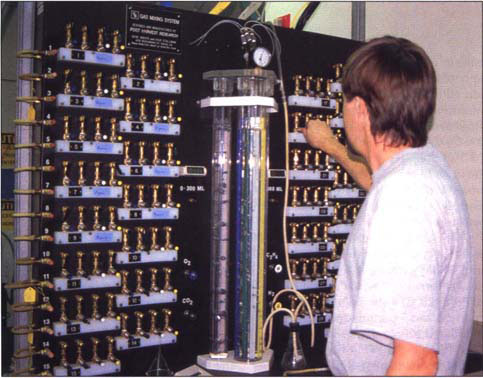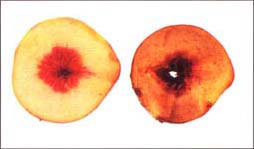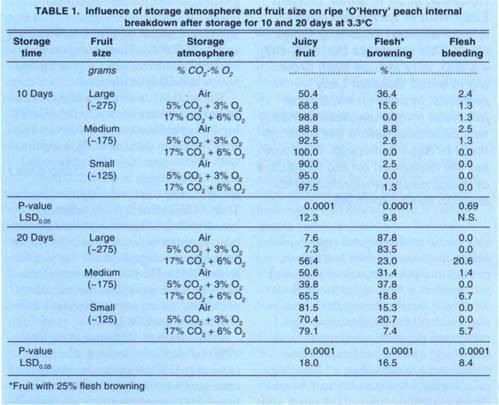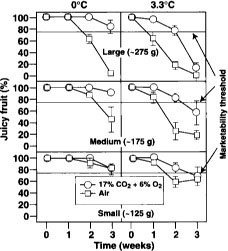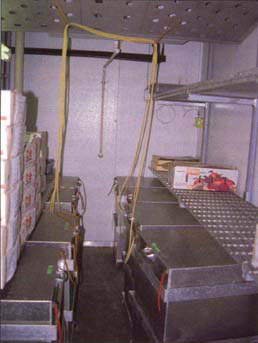All Issues
Peach size affects storage, market life
Publication Information
California Agriculture 53(5):33-36. https://doi.org/10.3733/ca.v053n05p33
Published September 01, 1999
PDF | Citation | Permissions
Abstract
During the 1995 season, large (~275g), medium (~175g) and small (~125g) ‘O'Henry’ peaches were stored in either air, 5% CO2 + 2% O2 or 17% CO2 + 6% O2 at 380F (3.30C). Large ‘O'Henry’ peaches benefited more from the 17% CO2 + 6% O2 than from either the 5% CO2 + 2% O2 or the air storage treatment. During the 1996 season, large, medium and small ‘Elegant Lady’ and ‘O'Henry’ peaches were stored in air or in 17% CO2 + 6% O2 at either 320F (00C) or 380F. Fruit size, storage atmosphere and temperature all had significant effects on chilling injury development. Small peaches stored in air at 320F had a longer market life than large fruit. At both storage temperatures, large ‘Elegant Lady’ and ‘O'Henry’ peaches had a longer market life under controlled atmosphere than under air storage. However, at 380F, small ‘Elegant Lady’ fruit in controlled atmosphere showed browning in the flesh. This suggests that 17% CO2 + 6% O2 may induce flesh browning in small ‘Elegant Lady’ peaches. In both years, lack of juiciness (mealiness/leatheriness) was observed before the development of flesh browning. Thus market life depended on the incidence of mealiness/leatheriness rather than on flesh browning.
Full text
Gas mixing board with micrometering valves used to prepare different carbon dioxide and oxygen combinations.
The ‘Elegant Lady’ peach on the right shows symptoms of Cl (internal browning), in comparison with the healthy fruit on the left.
One of the most frequent complaints about apricots, peaches, nectarines, prunes and plums by consumers and wholesalers is lack of juiciness (flesh mealiness/leatheriness), flesh browning, black pit cavity, flesh translucency, red pigment accumulation (bleeding) and loss of flavor. These symptoms are caused by a physiological disorder known as internal breakdown or chilling injury. The onset and intensity of internal breakdown symptoms during postharvest handling varies according to cultivar, preharvest cultural practices, growing season environmental conditions and postharvest handling. These chilling injury symptoms normally appear during prolonged cold storage or after ripening at room temperature following cold storage. This physiological disorder is the main limitation on long-term storage and shipment to distant markets for chilling injury-susceptible peach and nectarine cultivars. In chilling injury-susceptible stone fruit, the greatest development of internal breakdown symptoms occurs at storage temperatures between 360F (2.20C) and 460F (7.80C). These temperatures are typical during transport and warehouse-handling operations.
Controlled atmosphere (CA) conditions have been claimed to delay chilling injury and extend postharvest life. A 17% carbon dioxide (CO2) combined with 6% oxygen (O2) atmosphere balanced in nitrogen is used commercially during overseas shipment by the TransFRESH Corp. A 5% CO2 combined with 2% O2 atmosphere has also been recommended for long-term shipment/storage (Carrier Corp. 1995; Kader 1992). Despite commercial use of these CA conditions, the reduction of chilling injury symptoms have been erratic and unreliable.
Prior research (Crisosto et al. 1997, 1999) has led us to believe that CA storage performance can be improved once we better understand the relationships between cultivar susceptibility and “orchard factors.” In this study, we investigated the role of fruit size on peach internal breakdown susceptibility under air and CA conditions. However, cultural practices such as irrigation, fruit canopy position and leaf nitrogen status also affect, in low intensity, the onset of internal breakdown symptoms.
1995 season
As a first step, we compared the market life of ‘O'Henry’ peaches stored at 380F (3.30C) under ethylenefree air or 5% CO2 + 2% O2 or 17% CO2 + 6% O2. We collected large (~275 g), medium (~175 g) and small (~125 g) peaches harvested at commercial maturity from a commercial packinghouse in Reedley immediately after packaging. During packaging, iprodione (Rovral) fungicide and wax were applied to the fruit. Fruit were transported within 2 hours to the F. Gordon Mitchell Postharvest Laboratory at the Kearney Agricultural Center and forced-air cooled overnight to a pulp temperature of approximately 320F (O0C). After cooling, the fruit were stored at 320F (O0C) for 4 days, then subdivided into four replications of 80 fruit for each size/atmosphere condition. The fruit were stored in 89-gallon (338-liter) sealed aluminum tanks under a continuous flow of ethylene-free air or 5% CO2 + 2% O2 CA or 17% CO2 + 6% O2 CA at 380F (3.30C). Flow rates and gas mixtures were established using a mixing board with micrometering valves. Supply and exhaust gas composition was monitored.
TABLE 1. Influence of storage atmosphere and fruit size on ripe ‘O'Henry’ peach internal breakdown after storage for 10 and 20 days at 3.30C
We withdrew four replications of 20 fruit for each size/treatment after 0, 10 and 20 days storage (simulating overseas shipment). The fruit were ripened at 680F (200C) until, flesh firmness reached 2 to 3 pounds-force (lbf), then evaluated for incidence of chilling injury. For all of the following experiments, we evaluated chilling injury symptoms as flesh browning (FB) (score 1-6, with 1 = no FB to 6 = severe FB); texture (juicy, mealy or leathery); and bleeding (light, moderate or severe). At the same time, an informal taste panel evaluated the presence of “off flavors.” The end of market life was determined when more than 25% of the fruit were mealy or 15% of the fruit had an FB score of 3 (25% FB) or greater.
1996 Season
Based on the results of our 1995 research, only the ethylene-free air and 17% CO2 + 6% O2 CA treatments were used in these tests. Large, medium and small ‘Elegant Lady’ and ‘O'Henry’ peaches were collected from the packinghouse, cooled and stored at 320F (00C) for 4 days as described previously. Stone fruit were stored in 89-gallon (338-liter) sealed aluminum tanks under a continuous flow of ethylene-free air or 17% CO2 + 6% O2 CA at either 320F (00C) or 380F (3.30C). Four replications of 20 fruit each for each size/treatment/temperature were withdrawn after 0, 7, 14 and 21 days storage (simulating overseas shipments). We evaluated the fruit's chilling injury symptoms after ripening.
We used a factorial design arranged in a split-split plot in this experiment. The design included two main treatments (air and controlled atmosphere storage conditions) and three subtreatments (small, medium and large fruit) at 320F (00C) and 380F (3.30C). The data were subjected to analysis of variance (ANOVA) prior to the Least Significant Differences (LSD) mean separation using the SAS program.
Size plays a role in 1995
Fruit size played an important role in chilling injury (mealiness, leatheriness and FB) development under air and CA storage conditions for ‘O'Henry’ peaches (table 1). After 10 days of air storage, 50% of large, 89% of medium and 90% of small fruit remained juicy. FB incidence was 36% for large, 9% for medium and 3% for small fruit. After 20 days of air storage, 8% of the large fruit were juicy and 88% had FB. Medium and small fruit in air storage had 51% and 82% remaining juicy, respectively. FB was present in 31% and 15% of the medium and small size fruit, respectively. In both air and CA stored fruit, mealiness symptoms became visible earlier than FB symptoms. FB symptoms developed earlier and more intensely in large fruit than in medium and small fruit.
After 10 and 20 days storage, a significantly higher percentage of large fruit remained juicy and had less FB in the 17% CO2 + 6% O2 CA treatment than in the 5% CO2 + 2% O2 CA treatment or the air treatment. Fifty-six percent of the large fruit remained juicy and 23% had FB in the 17% CO2 + 6% O2 treatment after 20 days of storage. In both the air and 5% CO2 + 3% O2 CA storage, less than 8% of the fruit remained juicy and more than 80% had FB after this same 20-day storage period. More of the medium fruit remained juicy and had a lower incidence of FB in the 17% CO2 + 6% O2 CA treatment than in the 5% CO2 + 2% O2 CA or air treatment after 10 days of storage. After 20 days of storage, juiciness and FB incidence of medium fruit were similar in all storage conditions. For the small fruit, storage atmosphere did not have a significant effect on the percentage remaining juicy after 10 or 20 days. The incidence of flesh bleeding was low, and it was not affected by fruit size or storage time under air storage conditions. Large fruit had a 21% incidence of flesh bleeding after 20 days storage in 17% CO2 + 6% O2 CA.
Chilling injury related to size, 1996
The incidence of chilling injury was related to fruit size and storage conditions. After 14 days at 320F (00C), large CA-stored fruit had a higher percentage remaining juicy (87%) than large air-stored fruit (21%). With large fruit, CA storage at 320F (00C) was necessary to maintain a high percentage of juicy fruit after 14 days. After 21 days storage in air at 320F (00C), only 21% of the large size fruit were juicy, compared to 67% of the CA-stored fruit (fig. 1). More than 85% of small and medium ‘Elegant Lady’ fruit were juicy under CA (17% CO2 + 6% O2) at O0C, even after 21 days storage.
At 380F (3.30C), ‘Elegant Lady’ fruit developed mealy/leathery flesh in all three sizes tested. The first symptoms became visible on the large air-stored fruit after 7 days and for medium and small sizes after 14 days. In the large fruit, CA significantly delayed the development of chilling injury symptoms. After 14 days, 75% of the large CA-stored fruit remained juicy, as compared to 31% of the large fruit from air storage. After 21 days, there was no difference between the large CA-stored and air-stored fruit with respect to juiciness. Medium CA-stored fruit had 75% and 54% remaining juicy after 14 and 21 days storage, respectively. In air storage, only 31% remained juicy after 14 days and 8% after 21 days storage. CA storage did not have any significant benefits for small fruit. In fact, the percentage of small fruit remaining juicy was lower in CA storage than in air storage after 21 days.
In ‘Elegant Lady’ peaches stored at 320F (00C), FB became visible after 21 days only in the large fruit. CA storage limited the development of FB in large fruit. Small and medium ‘Elegant Lady’ peaches did not develop any FB when stored at 320F (00C) (data not shown). In fruit stored at 380F (3.30C), FB appeared after 14 days in large peaches and after 21 days in medium and small peaches. CA (17% CO2 + 6% O2) reduced FB development in medium and large fruit. However, flesh browning was observed in the small fruit when stored under CA at 380F (3.30C) for longer than 14 days. Further studies need to be carried out to determine if these symptoms in small ‘Elegant Lady’ fruit are a consequence of high CO2 and/or low oxygen injury.
Fig. 1. Influence of temperature, storage atmosphere and fruit size on ‘Elegant Lady’ peach juiciness, 1996. Vertical bars represent + SE.
Fig. 2. Influence of temperature, storage atmosphere and fruit size on ‘O'Henry’ peach juiciness, 1996. Vertical bars represent +SE.
CA storage was necessary to maintain the juiciness of large ‘O'Henry’ peaches. After 14 days at 320F (00C), a higher percentage of large CA-stored fruit remained juicy (100%) than of large air-stored fruit (63%). After 21 days at 320F (00C), large CA-stored fruit still had a higher percentage remaining juicy (83%) than fruit from the air-storage treatment (4%). After 21 days at 320F (00C), 92% of the medium fruit stored under CA remained juicy, compared to 45% of the medium fruit stored in air. For small ‘O'Henry’ fruit stored under CA at 320F (00C), chilling injury symptoms did not develop at important levels even after 21 days (fig. 2).
All three sizes of ‘O'Henry’ peaches showed symptoms of chilling injury when stored at 380F (3.30C). After 7 days in air storage, 62% of the large, 84% of the medium and 92% of the small fruit were juicy (fig. 2). With large fruit, CA provided significant protection against development of chilling injury. After 14 days, 77% of CA-stored fruit were juicy, as compared to 17% of air-stored fruit. After 21 days, it did not make any difference with respect to the percentage remaining juicy whether the fruit were stored in CA or air. With the medium CA-stored fruit, 83% and 57% remained juicy after 14 and 21 days storage in CA, respectively. In air storage, 25% and 19% remained juicy after 14 and 21 days, respectively. CA storage did not have any important benefit for small fruit.
Controlled environment room with aluminum tanks containing boxes of peaches. Controlled atmospheres prepared with the mixing board were introduced into the tanks.
No flesh browning at 320F in CA
FB symptoms were not visible in the three sizes of ‘O'Henry’ peaches stored under CA conditions at 320F (00C) for 21 days. Small and medium fruit did not develop any FB when stored in air at 320F (00C) for 14 days (data not shown). After 21 days in air storage, 100% of the large, 59% of the medium and 13% of the small fruit had FB. FB appeared after 14 days in all sizes of ‘O'Henry’ peaches stored in air at 380F (3.30C) (data not shown). After 21 days air storage, 100% of the large fruit, 85% of the medium fruit and 42% of the small fruit had FB. After 21 days, the CA (17% CO2 + 6% O2) treatment reduced FB development for medium and large fruit to 67% and 43%, respectively.
In all of these tests, fruit lost its juiciness at least 1 week before browning appeared. This agrees with observations over the last 5 years of fruit grown in the San Joaquin Valley (Crisosto et al. 1999). For this reason, we consider lack of juiciness (mealiness or leatheriness) to be a more accurate indicator of internal breakdown than FB. Trained panelists detected the lack of juiciness and “off flavors” of ‘Elegant Lady’ and ‘O'Henry’ fruit before expression of visible chilling injury symptoms (data not shown).
We used regression equations to predict market life of ‘Elegant Lady’ and ‘O'Henry’ peaches stored at 320F (00C) or 380F (3.30) in air or CA. Predicted market life was based on incidence of chilling injury for both peach cultivars, but does not include the 4 days storage at 320F (00C) prior to the main storage treatment. Under air-storage conditions, predicted maximum market life at 320F (00C) of large, medium and small ‘Elegant Lady’ peaches was 9, 19 and 21 + days, respectively. Under CA-storage conditions, predicted maximum market life at 320F (00C) of large, medium and small ‘Elegant Lady’ fruit was 19, 21 + and 21 + days, respectively. The three similar sizes of ‘O'Henry’ fruit lasted 13, 16 and 21 + days in air storage at 320F (00C), respectively. All three sizes of ‘O'Henry’ fruit lasted 21 + days in CA storage at 320F (00C).
The predicted market life of ‘Elegant Lady’ in air at 380F (3.30C) (minimum market life) was 4, 8 and 21 days for large, medium and small sizes, respectively. The predicted minimum market life of ‘Elegant Lady’ fruit in CA was 9, 15 and 16 days for sizes large, medium and small, respectively. Large, medium and small ‘O'Henry’ fruit stored in air at 380F (3.30C) had a minimum market life of 5, 6 and 12 days, respectively. Large, medium and small ‘O'Henry’ fruit stored in CA at 380F (3.30C) had a predicted minimum market life of 14, 16 and 18 days, respectively.
Injury occurs faster at 380F
Chilling injury symptoms developed more rapidly and with greater intensity at 380F (3.30C) than at 320F (00C). In all of the cases, fruit mealiness/leatheriness symptoms developed earlier than FB.
Fruit size influenced the onset and intensity of chilling injury, and thus influenced fruit market life potential. Large fruit developed chilling injury symptoms earlier and with greater intensity than medium and small fruit under the two storage temperature conditions.
The 17% CO2 + 6% O2 controlled atmosphere applied constantly was more effective than the 5% CO2 + 2% O2 controlled atmosphere at delaying symptoms of chilling injury for medium and large fruit.
A continuously applied controlled atmosphere (17% CO2 + 6% O2) was not beneficial for the storage of small ‘Elegant Lady’ or ‘O'Henry’ peaches. Furthermore, at 380F (3.30C), small ‘Elegant Lady’ peaches developed chilling injury earlier and with greater intensity in controlled atmosphere than in air storage.



